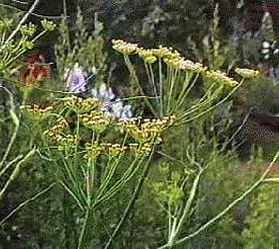|

| Botanical Name |
Foeniculum
vulgare |

|
| Common Name |
English:
Fennel |
| Family |
Umbelliferae
(Apiaceae) |
| Parts Used |
Leaves,
stems, roots, seeds and oil. |
| Medicinal Property |
A
sweet aromatic, diuretic herb that relieves digestive problems, increase
milk flow, relaxes spasms and reduces inflammation. Internally used for
indigestion, wind, colic and insufficient lactation (seeds), urinary
disorders (roots). Externally for mouthwash, for gum disease and sore
throat. |
| Chemistry |
The
essential oil content varies from 2.5 – 6.5 % which contains d-pinene,
camphene, d-L-phellandrene,
dipentine, 50-60 % anethol, fenchone, methyl chavicol, aldehyde and anisic
acid. The seed constitute protein, fat, crude fiber, vit. A, B & C. |
| Description |
A
stout, erect, glabrous, aromatic herb up to 1.8 m in height; leaves 3-4
times pinnate with very narrow, linear or subulate segments; flowers
small, yellow, fragrant; fruits oblong, ellipsoid or cylindrical, greenish
brown. |
| Distribution |
Originated
from Mediterranean Europe and Western Asia. Cultivated in different parts
of the World. |
| Economics |
|
| Warning |
|
|
|